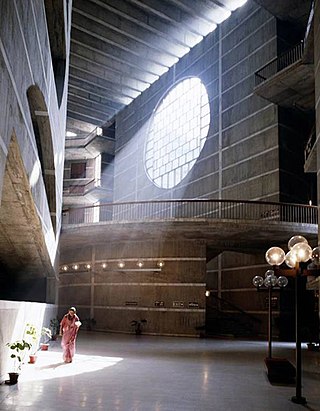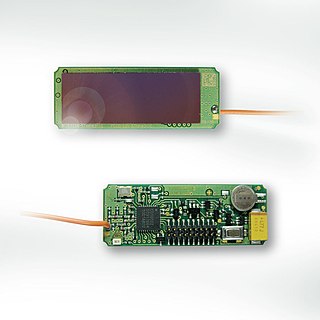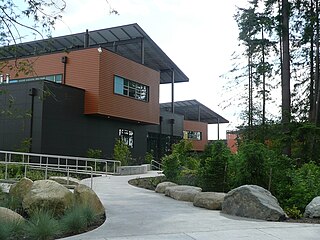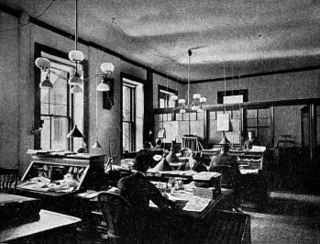Daylight harvesting systems use daylight to offset the amount of electric lighting needed to properly light a space, in order to reduce energy consumption. This is accomplished using lighting control systems that are able to dim or switch electric lighting in response to changing daylight availability. The term Daylight Harvesting has become the standard in the fields of lighting, sustainable architecture, and active daylighting industries.
Daylight harvesting systems are typically designed to maintain a minimum recommended light level. [1] This light level will vary according to the needs and use of the space; for example, the commonly recommended light level for offices is 500 Lux (or around 50 foot-candles) on the desktop. [2]
All daylight harvesting systems use a light level sensor, a photosensor, to detect the prevailing light level, luminance or brightness, in open-loop or closed-loop systems. Photosensors are used to adjust electric lighting based on the available daylight in the space. [3] [4] In an open-loop system, the photosensor detects the amount of available daylight only, and can be positioned on the building's exterior wall or roof, or inside the building facing the window or skylight. In a closed-loop system, the photosensor detects the total photometric amount of light, from both daylight and electric sources in the space. [5] [6] For example, in an office a closed-loop photosensor can be positioned on the ceiling facing the desktops in order to detect the amount of light on the work surface, as placing the sensor on the desktop itself would be impractical. When sensors were placed on desktops in an office building, an penalty of 24% on energy saving occurred. [7] In both the open- and closed-loop configurations, the signal from the photosensor must be carefully calibrated to accurately indicate the effect of exterior daylight variations on the light level on 'important function' areas in the space. [8]
The signal from the photosensor is interpreted by a lighting control system module, an automated light switching device, in the electric lighting system which can reduce the electric lighting, by shutting off or dimming fixtures as appropriate. [9] [10] If the electric lighting is dimmable, then the artificial lighting may be continuously adjusted in proportion to the amount of daylight available. If the electric lighting is on-off only, then an electric lighting fixture or lamp must remain on at full output until daylight can meet the entire recommended light level for the space. Non-dimming variants include having multiple non-adjacent light fixtures such as alternate units in the ceiling 'grid layout,' or daylight source adjacent fixtures near windows or skylights, linked for module on-off switching. Another variant of on-off switching is step switching (sometimes referred to as "bi-level switching"), in which multiple lamps in a single light fixture can be switched on and off independent of each other. This allows for typically one or two steps between full output and zero. [11] [12]
Dimming systems are generally more expensive than on-off systems. They have the potential to save more energy, because they can reduce electric light output when daylight can only partially meet the needs of the space. However, dimming systems may also require a little more energy for their basic operation. [13] If a dimming system is well-calibrated, the occupants of the space will not notice changes in electric lighting due to daylight harvesting, whereas they are very likely to notice the changes due to on-off or step switching.
Several studies have recorded the energy savings due to daylight harvesting. Energy savings for electric lighting in the range of 20-60% are common. [14] Savings are very dependent on the type of space the light harvesting control system is deployed in, and its usage. [4] Clearly, savings can only accrue in spaces with substantial daylight where electric lighting would have been otherwise used. Therefore, daylight harvesting works best in spaces with access to conventional or clerestory windows, skylights, light tube groups, glass block walls, and other passive daylighting sources from sunlight; and where electric lighting would otherwise be left on for long periods. Such spaces have included offices, atria, interior public multistory plazas and shopping mall courts, and schools.
It is too simplistic to try to increase energy savings by increasing the size of windows. Daylight over-illumination may cause glare for occupants, causing them to deploy blinds or other window shading devices, and compromising the daylight harvesting system. Even partially deployed venetian blinds can cut energy savings in half. [15]
Impressive energy savings estimates may not be realized in practice due to poor system design, calibration, or commissioning. Systems that dim or switch electric lighting in a distracting manner, or that produce overall light levels that are perceived as too low, can be sabotaged by occupants. [16] (For example, simply taping over a sensor will create constant electric lighting at maximum output.)
The adoption of daylight harvesting technologies has been hampered by high costs and imperfect performance of the technologies. However, studies have shown that by using daylight harvesting technologies, owners can see an average annual energy savings of 24%. [17]
One method of predicting energy savings is to use commercially available software programs, such as TRACE 700 or (freeware) DOE-2, which considers thermal loads. [18]
There is an incremental cost to daylight harvesting systems. Dividing this cost by the annual energy savings provides a "simple payback", the number of years for the system to pay for itself. [19] The shorter the calculated payback period, the more likely it is that a building owner will invest in the system. Costs vary for a whole host of local factors, but generally if energy costs rise, or the cost of the control hardware and installation falls, the payback period will be reduced.
The green building-sustainable building movement encourages sustainable architecture design and building practices. Various green building ecolabel certification marks exist around the world, such as LEED, BOMA Best, BREEAM, HKBeam, and Green Star. All of these programs offer points for various building design features that promote sustainability, and certification at various levels is awarded for reaching a given number of points. One of the principal ways to gain points is through energy saving measures. [20] Therefore, daylight harvesting is a common feature of green buildings. [21] Thus green building practices are increasing the production of daylight harvesting components, leading to lower prices.
Many electric utilities provide financial incentives for their customers to save energy. One such incentive is rebates on daylight harvesting systems [22] , which also reduces payback periods.
In addition, energy codes and standards are beginning to address daylight harvesting. For example, the California Energy Code Title 24-2008 recognizes primary and secondary daylight zones. At least 50% of the general lighting in primary zones must be controlled separately from other lighting, with automatic control required for larger zones. The code encourages automatic daylight harvesting in secondary zones by awarding power adjustment factor credits that can be applied to the lighting design. [23] The 2009 International Energy Conservation Code (IECC) recognizes daylight zones around vertical fenestration and skylights, and requires that the lighting in these zones be controlled separately from the general lighting in the space.[ citation needed ] The 2010 ASHRAE 90.1 energy standard, expected to be published in the fall 2010, is also expected to address daylight harvesting. Meanwhile, ASHRAE 189.1, the first of a generation of sustainable construction codes, defines daylight zones and requires daylight harvesting control.[ citation needed ]

Daylighting is the practice of placing windows, skylights, other openings, and reflective surfaces so that direct or indirect sunlight can provide effective internal lighting. Particular attention is given to daylighting while designing a building when the aim is to maximize visual comfort or to reduce energy use. Energy savings can be achieved from the reduced use of artificial (electric) lighting or from passive solar heating. Artificial lighting energy use can be reduced by simply installing fewer electric lights where daylight is present or by automatically dimming or switching off electric lights in response to the presence of daylight – a process known as daylight harvesting.

Lighting or illumination is the deliberate use of light to achieve practical or aesthetic effects. Lighting includes the use of both artificial light sources like lamps and light fixtures, as well as natural illumination by capturing daylight. Daylighting is sometimes used as the main source of light during daytime in buildings. This can save energy in place of using artificial lighting, which represents a major component of energy consumption in buildings. Proper lighting can enhance task performance, improve the appearance of an area, or have positive psychological effects on occupants.

A compact fluorescent lamp (CFL), also called compact fluorescent light, energy-saving light and compact fluorescent tube, is a fluorescent lamp designed to replace an incandescent light bulb; some types fit into light fixtures designed for incandescent bulbs. The lamps use a tube that is curved or folded to fit into the space of an incandescent bulb, and a compact electronic ballast in the base of the lamp.

Architectural lighting design is a field of work or study that is concerned with the design of lighting systems within the built environment, both interior and exterior. It can include manipulation and design of both daylight and electric light or both, to serve human needs.

The EnOcean technology is an energy harvesting wireless technology used primarily in building automation systems, but also in other application fields such as industry, transportation, and logistics. The energy harvesting wireless modules are manufactured and marketed by the company EnOcean, headquartered in Oberhaching near Munich. The modules combine micro energy converters with ultra low power electronics and wireless communications and enable batteryless, wireless sensors, switches, and controls.
Building automation (BAS), also known as building management system (BMS) or building energy management system (BEMS), is the automatic centralized control of a building's HVAC, electrical, lighting, shading, access control, security systems, and other interrelated systems. Some objectives of building automation are improved occupant comfort, efficient operation of building systems, reduction in energy consumption, reduced operating and maintaining costs and increased security.

Cove lighting is a form of indirect lighting built into ledges, recesses, or valances in a ceiling or high on the walls of a room. It directs light up towards the ceiling and down adjacent walls. It may be used as primary lighting, or for aesthetic accent, especially to highlight decorative ceilings. Cove lighting is valued because it hides the fixtures, and because it provides a very even light.

A lighting control system incorporates communication between various system inputs and outputs related to lighting control with the use of one or more central computing devices. Lighting control systems are widely used on both indoor and outdoor lighting of commercial, industrial, and residential spaces. Lighting control systems are sometimes referred to under the term smart lighting. Lighting control systems serve to provide the right amount of light where and when it is needed.

Light tubes are structures that transmit or distribute natural or artificial light for the purpose of illumination and are examples of optical waveguides.

An occupancy sensor is an indoor device used to detect the presence of a person. Applications include automatic adjustment of lights or temperature or ventilation systems in response to the quantity of people present. The sensors typically use infrared, ultrasonic, microwave, or other technology. The term encompasses devices as different as PIR sensors, hotel room keycard locks and smart meters. Occupancy sensors are typically used to save energy, provide automatic control, and comply with building codes.

Manitoba Hydro Place (MHP) is an office tower serving as the headquarters building of Manitoba Hydro, the electric power and natural gas utility in the province of Manitoba, Canada. Located at 360 Portage Avenue in downtown Winnipeg and connected to the Winnipeg Walkway system, Manitoba Hydro Place received LEED Platinum certification in May 2012, making it the most energy-efficient office tower in North America and the only office tower in Canada to receive the LEED Platinum rating.

Marysville Getchell High School is a public high school in Marysville, Washington, United States. It is part of the Marysville School District.

The United States is the second-largest single consumer of energy in the world. The U.S. Department of Energy categorizes national energy use in four broad sectors: transportation, residential, commercial, and industrial. Energy usage in transportation and residential sectors is largely controlled by individual domestic consumers. Commercial and industrial energy expenditures are determined by businesses entities and other facility managers. National energy policy has a significant effect on energy usage across all four sectors.

Hybrid solar lighting (HSL) or hybrid lighting systems combine the use of solar with artificial light for interior illumination by channelling sunlight through fiber optic cable bundles to provide solar light into rooms without windows or skylights, and by supplementing this natural light with artificial light—typically LED—as required.

Light in school buildings traditionally is from a combination of daylight and electric light to illuminate learning spaces, hallways, cafeterias, offices and other interior areas. Light fixtures currently in use usually provide students and teachers with satisfactory visual performance, i.e., the ability to read a book, have lunch, or play basketball in a gymnasium. However, classroom lighting may also affect students' circadian systems, which may in turn affect test scores, attendance and behavior.

Sustainable lighting is lighting designed with energy efficient light sources. "There are simple design strategies and some materials that can facilitate the energy saving advantages of natural light. Light colored interiors and open floor plans are good choices. This approach also augments artificial light efficiency. Energy efficient lighting is not simply finding the most light for the least wattage or the longest lasting light bulb. Proper sizing of the light to the needs of the location and the tasks that will be performed, called task lighting, is an energy saving strategy."

A skylight is a light-permitting structure or window, usually made of transparent or translucent glass, that forms all or part of the roof space of a building for daylighting and ventilation purposes.

The Terry Thomas Building, located in the South Lake Union neighborhood of Seattle, Washington is a sustainable, LEED-certified office building completed in 2008. The Terry Thomas is Seattle's first commercial office building structure developed in decades without central air conditioning. It was designed by Seattle-based architectural firm Weber Thompson, who also designed the interiors of the building and use it as their headquarters.

Prism lighting is the use of prisms to improve the distribution of light in a space. It is usually used to distribute daylight, and is a form of anidolic lighting.

Daylight redirecting film (DRF) is a thin, flexible plastic film which can be applied to a window to refract or reflect incoming light upwards so that the deeper parts of the room are lit more evenly. It can be used as a substitute for opaque blinds. It is a form of prism lighting.